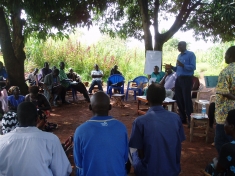Uganda's Dams Leave Affected People Behind
The government of Uganda has been on a dam-building binge for years now. While Uganda clearly needs more electricity for its development, these huge projects are creating difficult-to-solve problems that are often not resolved by the time construction is complete.The latest big dam proposed for Uganda’s rivers is Karuma, which will be built by China on the Nile River. The dam was first proposed in 1995, but it failed to take off thanks to the World Bank’s efforts to prioritize Bujagali Dam instead, as well as a corruption scandal with the dam’s contractor.
Norwegian energy company Norpak was awarded the contract to build a 250 MW dam at Karuma Falls, but it pulled out in 2009. The Ugandan government then repossessed the project in 2010 and hired an Indian firm, Energy Infratech, to undertake new feasibility studies and re-engineer the dam for a higher capacity. Infratech redesigned the project to a target of 750 MW using a 9km “tailrace tunnel” running through Murchison Falls National Park. The project has since been scaled back to 600 MW. To save resources and match the available water flow, international energy experts’ advice is that 450 MW would be appropriate.
In 2010, the Ugandan Energy Ministry invited bids for the construction of dam. But the project has been mired in controversies, raising a multitude of questions from experts about the bidding process, the project design, qualifications of the project manager, and the realistic amount of power the project can generate. Last year, more than 10 government officials from the ministries of Energy, Finance, Works, Water and Environment faced police investigations over alleged bribery to prequalify incompetent contractors for the project.
Three years after restarting the project, a Chinese firm, Sinohydro, was finally given the contract to build the hydropower project and transmission line. The project is expected to cost US$2.2 billion (including the transmission system). Construction is slated to start before the end of 2013 and take at least five years to complete.
However, this might be overly optimistic, following fresh wrangles that threaten to delay the project. A rival Chinese company, China International Water and Electric Corporation (CWE), has gone to court to challenge the award of the contract to Sinohydro. The project-affected communities, too, have petitioned the government over unfair compensation for their land and property by the company.
Community concerns
The Karuma Dam project will displace approximately 300 people in the four villages of Karuma, Awoo, Nora, and Akurudia, according to the official list from government. The project-affected people have expressed displeasure with replacement lands and property valuation process, saying that the company is under-paying them. The affected people are concerned that the rates used by government and the company are inconsistent with inflation trends in the country.
More than 54 people petitioned the Electricity Disputes Tribunal on behalf of the project-affected people, seeking to halt construction of the dam until the “meager” compensation rates are revised. Ogik William, a resident of Awoo village, said: “We also want electricity, and we want the project, but we need to be reasonably compensated. We want the right value for our property. We will not accept to be cheated.”
The Government has promised to look into these concerns and find ways to resolve their problems. Yet it has also said it is determined to fast-track Karuma Dam, which could lead to the prioritization of engineering and construction issues, leaving the sometimes complicated mitigation of the problems the dam might cause to another day. This was one of the lessons of the now-complete Bujagali Dam.
The Bujagali Dam faced numerous social, economic and environmental challenges that delayed the dam construction for more than ten years while the project underwent investigations over bribery claims and reviews of the dam design and capacity. The dam cost kept on growing from $580 million at inception to $860 million and finally $902 million ($3.6 per megawatt) at completion. Independent investigations by the parliamentary ad hoc committee on energy put the dam’s actual cost at $1.3 billion ($5.2 per MW or more). In Africa and other continents, construction of hydropower plants more typically cost between $1.0-1.7 per MW capacity.
Lessons from Bujagali
The Karuma Dam is off to a poor start. Its planning process is already mired in corruption allegations. The dam’s size has jumped from 200 MW to 450 MW to 750 MW, and now 600 MW. The final cost of the project is anyone’s guess. Affected people are concerned that they will be on the losing end of Uganda’s latest big dam project. Karuma Dam’s proponents should tread carefully, and ensure the project doesn’t become a white elephant.
Betty Obbo is the information officer at the National Association of Professional Environmentalists in Uganda.



